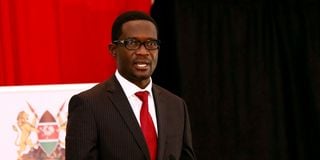Media owners, time to speak up

Communications Authority of Kenya (CA) Director General Ezra Chiloba. CA said six TV stations violated the Programming Code during the coverage of opposition demos on Monday
On December 30, 2007, seemingly out of the blue, then-Internal Security minister John Michuki banned live television news coverage at the height of the infamous post-election violence during which more than 1,000 Kenyans died and thousands of others were forcibly displaced.
The reasoning, although not categorically spelt out at the time, was that live coverage of the gory events was exacerbating the violence, and probably encouraging copycat carnage, especially in some hotspots in Rift Valley, Nyanza and Nairobi.
He was soon reminded that there was no law that gave him such powers that made neither practical nor commercial sense.
The second time that the government totally gagged the media in a similar fashion was during Mr Raila Odinga’s swearing-in as the “People’s President” on January 30, 2018.
On this occasion, it simply switched off the independent broadcasters — Citizen TV, NTV and KTN — and those who wished to follow the proceedings could only do so on YouTube.
However, on this occasion, the mock swearing-in may have had a beneficial effect, for it birthed the much-maligned Handshake between President Uhuru Kenyatta and opposition leader Raila Odinga, which calmed the turbulent political waters.
On Wednesday this week, leading media houses were again reminded just how vulnerable they are by the Communication Authority of Kenya when its director-general, Mr Ezra Chiloba, officially censured them for airing live content “that could cause panic or incitement to the public, threatening peace, and cohesion in the country” against the tenets of the broadcast programming code.
Their sin? They had the temerity to cover live the events that occurred on Monday, March 20, during the demonstrations organised by Mr Odinga demanding that the cost of living comes down, among other demands.
“While the authority promotes the freedom of the press,” Mr Chiloba wrote in a press release, “it is imperative that all broadcasters exercise caution in live broadcast coverage to avoid scenes that would be detrimental to peace and cohesion”.
It would have been best if he had called a press conference to explain this rather mystifying statement, for it would have helped broadcast journalists on the ground. Even those unfamiliar with the trade know that live coverage means recording events as they happen.
Exercise caution
Does the phrase “exercise caution” mean shifting the camera lens away from any particular happening and training it to something less sensitive? Would it, perhaps, mean avoiding recording protesters pelting police with stones or police lobbing teargas canisters on demonstrators to disperse them?
Either Mr Chiloba is feigning ignorance of what journalists do, or he is under pressure to sanitise the unsavoury reality. Either way, the directive puts journalists in a very awkward position.
A story, whose truth I cannot vouch for, goes that one day, a cub news reporter was once sent by his editor to cover an event at Mzee Jomo Kenyatta’s Gatundu home. Along the way, a deadly road accident prevented him from reaching Mzee’s home on time and he had to turn back.
On reaching the newsroom, he explained what had happened and was then asked what had caused the accident and how many people died, to which he had no answer.
It is said that his was the shortest journalistic career on record, which is just as well, for he went on to write some of the greatest novels in the world.
Nowhere in the Broadcast Programming Code does it say that broadcasters are in violation of the code by airing the truth. The closest it comes to regulating the content of this nature — mass demonstrations — is where it exhorts a media house “to ensure that no broadcasts by its station glorifies violence or depicts violence in an offensive manner; or are likely to incite, perpetuate content that constitutes hatred, or vilify any person or section of the community”.
Another one reads that “the presentation of news and commentaries must not be done in a way that would create unnecessary panic or alarm.”
What is most alarming about those statements is that not only are they too general, they could lead to sinister interpretations and become an existential threat to the business.
When Mr Chiloba writes that if media houses fail to adhere to the vague “obligations” they will have breached the code, he is essentially saying that broadcast licences can be cancelled or frequencies withdrawn, which means media owners ought to take notice for the threat is actually a gag order. Whether such a thing is legal, constitutional or wise is another matter altogether.
Mr Odinga has said the weekly demonstrations will continue, and has, in fact, doubled the frequency. It is time that media owners took a stand on whether to kowtow to Mr Chiloba’s fiat and lose credibility altogether, or call Mr Chiloba’s bluff and brace themselves for the consequences.
Mr Ngwiri is a consultant editor; [email protected]





